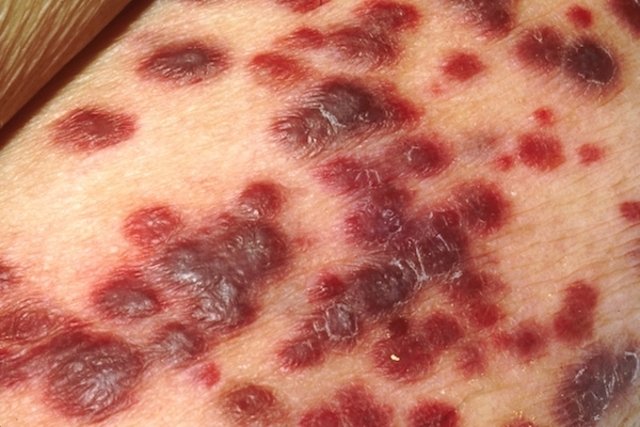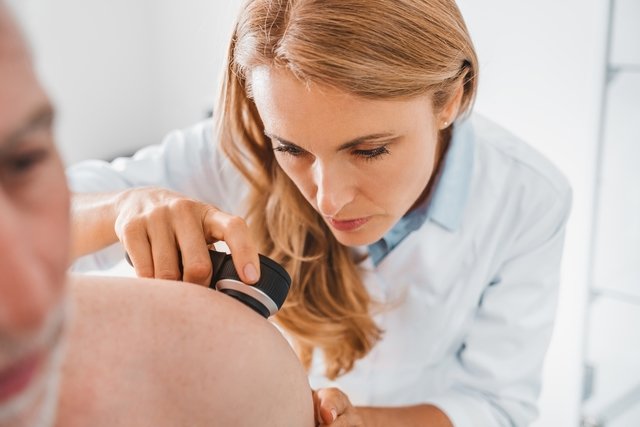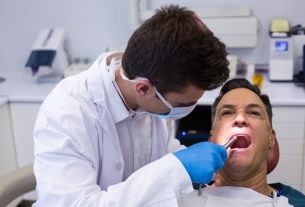Kaposi’s sarcoma is a skin cancer that develops in the innermost layers of blood vessels, causing symptoms such as purplish-red plaques on the skin, which can appear anywhere on the body.
This type of skin cancer is caused by the herpes virus 8 (HHV-8), which can be transmitted sexually or through saliva, mainly affecting people with a weakened immune system, such as people who have had a transplant or have AIDS.
The treatment of Kaposi’s sarcoma is carried out by an oncologist, who may recommend chemotherapy, radiotherapy or immunotherapy, for example.
Sensitive content
This image may contain content that is uncomfortable for some people.

Kaposi’s sarcoma symptoms
The main symptoms of Kaposi’s sarcoma are:
- Purple-red, brown or black spots or plaques on the skin, spread over the body;
- Flat or raised skin lesions, which can be painful;
- Swelling of the lower limbs due to blocked lymph nodes;
- Spots near the affected region, especially in the groin;
- Chest pain and/or coughing up blood, when it affects the lungs;
- Abdominal pain, blood in the stool, diarrhea, constipation, nausea or vomiting, when affecting the gastrointestinal system;
- Pain in the mouth or difficulty eating, when it occurs in the lining of the mouth.
The symptoms of Kaposi’s sarcoma can vary according to the affected region of the body, such as the skin, especially the face, legs and feet, mucous membranes of the mouth, gums, intestines or anus, as well as organs such as the lungs or liver, for example.
It is important to consult an oncologist whenever symptoms of Kaposi’s sarcoma appear, especially in people with a weakened immune system, so that the diagnosis can be made and treatment can be started.
How to confirm the diagnosis
The diagnosis of Kaposi’s sarcoma is made by an oncologist, dermatologist or general practitioner through evaluation of symptoms and health history.
To confirm the diagnosis, the doctor must request a biopsy of the lesion to be analyzed in the laboratory and perform an immunohistochemical test.
Make an appointment with an oncologist in the nearest region:
Taking care of your health has never been easier!
In addition, the doctor may order other tests, according to the symptoms presented, such as X-ray, endoscopy, bronchoscopy, computed tomography or PET-CT, for example. Find out how PET-CT is done.
Possible causes
Kaposi’s sarcoma is caused by herpesvirus type 8 (HHV-8), which infects the innermost cells of blood vessels.
This virus can be transmitted through unprotected intimate contact, saliva, blood transfusion or injectable drug use.
Kaposi’s sarcoma generally affects people with a weakened immune system, and is therefore more common in people who have AIDS, have had a transplant or are elderly.
Types of Kaposi’s sarcoma
Kaposi’s sarcoma can be classified into 4 main types according to its cause:
- Classic Kaposi’s sarcoma: It is a rare type that evolves slowly, mainly affecting men over the age of 60, of Mediterranean, Middle Eastern or Eastern European origin, due to a natural weakening of the immune system with aging;
- Kaposi’s sarcoma associated with immunosuppression or iatrogenic: may appear after transplantation, especially of solid organs, due to the use of immunosuppressive medications to prevent organ rejection;
- Kaposi’s sarcoma associated with AIDS: which is the most common form of Kaposi’s sarcoma, being more aggressive and developing quickly;
- Endemic Kaposi’s sarcoma: It is a very aggressive type that affects young people in the African region.
Kaposi’s sarcoma can be fatal when it affects the blood vessels of other organs, such as the lungs, liver or gastrointestinal tract, causing difficult-to-control bleeding.
How the treatment is carried out
The treatment of Kaposi’s sarcoma must be carried out under the guidance of an oncologist who may indicate:
1. Surgery
Surgery may be recommended by the oncologist to remove spots, plaques or lesions on the skin, especially in cases of few lesions and in the case of classic Kaposi’s sarcoma, as it grows slowly.
This surgery can be performed with electrocoagulation or cryosurgery, for example.
2. Creams or ointments
Creams or ointments containing imiquimod may be recommended by your doctor to apply directly to skin lesions.
3. Highly active antiretroviral therapy
Highly active antiretroviral therapy, also known as HAART, is generally indicated in cases of Kaposi’s sarcoma caused by HIV infection.
This type of treatment prevents the HIV virus from causing further damage to the immune system, and in cases of endemic Kaposi’s sarcoma it can be done with other treatments.
4. Radiotherapy
Radiotherapy is used to eliminate Kaposi’s sarcoma cells and is recommended to complement surgical treatment to remove the prostate.
Radiotherapy can be applied by external radiation, through a machine that emits beams of radiation onto the region with Kaposi’s sarcoma, but it can also be done by brachytherapy, where radioactive material is placed inside or close to the cancer.
5. Chemotherapy
Chemotherapy uses drugs such as vinblastine, doxorubicin or paclitaxel, for example, which help destroy cancer cells.
This type of treatment can be done by applying the medicine directly to the lesion, in the form of an injection or ointment, or applied directly to the vein, for example.
6. Immunotherapy
Immunotherapy treatment helps increase the immune system’s response against cancer cells, which can lead to a decrease in the size of the cancer or delay its growth.
The main immunotherapeutics that may be indicated for Kaposi’s sarcoma are interferon alfa-2b and interleukin-12.
7. Target therapy
Targeted therapy uses drugs to help the immune system specifically identify and attack Kaposi’s sarcoma cells, having little effect on the body’s normal cells.
Some drugs used in targeted therapy for Kaposi’s sarcoma are bevacizumab or imatinib, for example.
In some cases, targeted therapy can be combined with radiotherapy or chemotherapy to increase the chance of cure.
Is there a cure for Kaposi’s sarcoma?
Kaposi’s sarcoma is curable, but it depends on the stage of the disease, age and state of the person’s immune system.

Sign up for our newsletter and stay up to date with exclusive news
that can transform your routine!
Warning: Undefined array key "title" in /home/storelat/public_html/wp-content/plugins/link-whisper-premium/templates/frontend/related-posts.php on line 12
Warning: Undefined array key "title_tag" in /home/storelat/public_html/wp-content/plugins/link-whisper-premium/templates/frontend/related-posts.php on line 13




